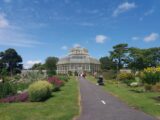Collecting and curating botanical samples as herbarium specimens dates back to the 16th century. The Italian physician Luca Ghini realised that dried plant specimens could be used for teaching medical students plant identification throughout the year, even when plant samples were not available during the winter.
Today there are over 3,500 herbaria across the world holding almost 400 million botanical specimens. The National Herbarium in the National Botanic Gardens, Glasnevin holds approximately 600,000 herbarium specimens dating from the early 1800s to the present day.
It contains the most complete collection for the island of Ireland but also contains specimens collected across the globe, from the arctic to Australia. Some of our specimens represent the first encounters of western scientists with plant species, such as the Handkerchief tree (Davidia involucrata). As such, they hold a wealth of information on natural and cultural history.
Herbarium specimens have tremendous potential outside of their primary uses to discover and describe flora. They have been used to track the movement of invasive species, to monitor changes in species composition and biodiversity assessments, to determine atmospheric changes and to uncover genetic changes over time. They are physical records of biological interaction and can be used for both scientific and historical study. Each specimen represents a snap-shot in time and as a collection they are an extensive time-series to interrogate.
What makes herbarium specimens so useful is the data contained on the label or on the notes associated with the specimen. A specimen without a label is almost worthless. The details of the plant name, collection location, collector, date and often additional notes on habitat, altitude or plant condition are immensely important.
The combined data from all these specimens allow us to track past changes and help predict future responses. However, to date we have catalogued data from only a limited number of the specimens within the herbarium – approximately 10% are fully digitised. This is mainly due to the large numbers within the collection but it is now changing with the help of digital cameras and automated imaging technologies. Images of herbarium specimens capture unique moments in history and represent hundreds or thousands of data points for each specimen. The National Herbarium has embarked on a project to take high-resolution images of all our specimens and to extract data from the collection. This is a long-term project, but to begin it we have started to work on the Irish collection of approximately 60,000 specimens. The DigiHerb project is co-funded by the North-West Europe Interreg programme and is a collaboration with two other herbaria in the North-West Europe region, the State Museum of Natural History in Karlsruhe, Germany and Ghent University, Belgium. The project aims to digitise material in each herbarium and to share the data on a combined portal (https://digiherb.symbiota.org/). We are using a high throughput imaging conveyor belt system to capture images of the specimens at each site. The data from the specimen labels is being manually extracted, but we are also running trials on AI data capture to speed up this process. The overall goal will be to have the images and data available to the public to facilitate further scientific and historical studies.
We are also working closely with the Digital Repository of Ireland, which is hosting the high resolution images and the associated data. In particular, we have started by sharing the Robert Lloyd Prager collection online on the DRI (https://repository.dri.ie/catalog/kd17sp309). This project was funded by the Nowlan Digitisation Grant scheme of the Royal Irish Academy. The Praeger collection represents one of the most important subsets of our collection. Praeger deposited specimens from his fieldwork across Ireland during which he created lists of species in each county. These lists were compiled into a catalogue of plants in Ireland, giving the most comprehensive census of plants across the island. This initial census has been added to throughout the years and forms the basis of our conservation assessments of Irish plants.
Of course, we have much more than Irish specimens in the National Herbarium. We have specimens of global significance from across the world and these will also be imaged in time. The imaging of the Irish specimens will be finished in August 2025, after which we hope to continue onto digitisation of the World collection.

